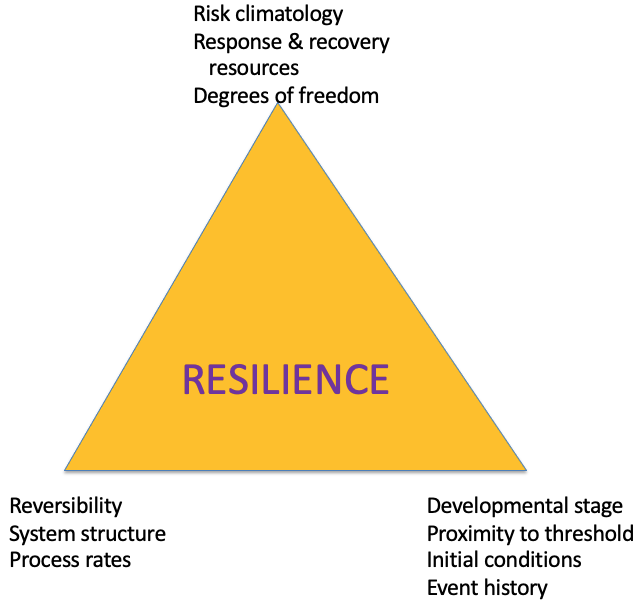The state of an Earth surface system (ESS) is determined by three sets of factors: laws, place, and history. Laws (L=L1, L2, . . . , Ln) are the n general principles applicable to any such system at any time. Place factors (P=P1, P2, . . . , Pm) are the m relevant characteristics of the local or regional environment. History factors (H = H1, H2, . . . , Hq) include the previous evolutionary pathway of the ESS, its stage of development, past disturbance, and initial conditions. Geoscience investigation may focus on laws, place, or history, but ultimately all three are necessary to understand and explain ESS.
I first started using the law-place-history (LPH) framework as a pedagogic device in my teaching, and as a sort of aide memoire framework in my research. Eventually I began invoking it more explicitly in my research and writing, and expressing it formally, as in the passage above lifted from Phillips, 2018.
In this note I apply the framework to the overused word but vitally important concept of resilience. Resilience is the ability or potential for an ESS (or a human system) to recover from a change or disturbance. In systems theory and mathematical terms, resilience is closely, and in some contexts directly, linked to dynamical stability. In that context resilience (as recovery or tendency to return toward the pre-disturbance state) is distinct from resistance, the ability to withstand or absorb changes in inputs or external forcings. Resistance and resilience are often conflated, however, and both concepts are certainly relevant in any assessments of risk and vulnerability.

Sandy beaches are resilient to most wave and wind events, and to construction projects of my grandson Andy Phillips.
The laws influencing resilience depend on the system in question and the change or perturbation under consideration. Resilience of an agricultural system to climate warming will be governed by a different set of laws, for instance, than resilience of a barrier island to a hurricane. In general, however, the aspects of laws that most affect resilience are threefold: reversibility, system structure, and process rates. Laws determine that some processes and changes are irreversible, or not. Damage or destruction to vegetation, for instance, is in many cases reversible; vegetation can recover. Others are irreversible—the deposits from a rockfall or mudflow are not going to move back upslope. The system structure—think of an ESS as a network, and the structure as how the network is wired or connected—is closely related to, and sometimes determines, dynamical stability. The rates of processes (e.g., plant growth, soil formation, evapotranspiration) determine how rapidly a system can respond.
Specific place factors, by definition, vary greatly. Again, however, certain types of place factors are especially relevant to resilience. One has to do with the “climatology” of risks or disturbances. In some cases, climatology per se is appropriate, with respect to resilience to floods, tornadoes, tropical cyclones, and such. More generally, climatology is used here to encompass factors such as the geographically specific frequency, durations, severity, and timing of the disturbance or risk factors. You may recognize these as being closely related to the factors typically considered in studies of the geography of natural hazards. The resources available for response and recovery are also critical. In human systems these are linked to material wealth, capital, and infrastructure, as well as human experience and expertise. In non-human systems or the non-human aspects of ESS, factors such as matter and energy, geographical space, and time come into play. Yet another important category of place factors has to do with the options or degrees of freedom available—how many different possibilities are available for responding to, say, a drought or an epidemic.
I’ll also lump in here a couple of place factor categories that, strictly speaking, are associated with resistance rather than resilience. Mechanical resistance or strength relative to the force of a disturbance is self-evidently important, along with absorption capacity.
History factors affecting resilience include initial conditions at the time of an event, such as antecedent moisture or river stages when a large rainstorm strikes, or the coincidence of natural hazards with seasonal population fluctuations. The stage of development or evolution also plays a role; some ESS are more resilient at earlier or more mature stages. The proximity of the system to thresholds is another key history factor, as is the timing and sequence of disturbance events (event history).

Most studies of resilience focus on only a few, or a single, factor. Much of my own work, for instance, has concentrated on system structure and dynamical stability, though other studies have addressed the role of history factors, and mechanical resistance. Engineers, social scientists and planners often focus on place factors. However, full understanding of resilience requires that all corners of the LPH triangle be considered.
______________________________________
Philliips, J.D., 2017. Laws, place, history and the interpretation of landforms. Earth Surface Processes & Landforms 42: 347-354 (attached).
Posted 3 May 2021
